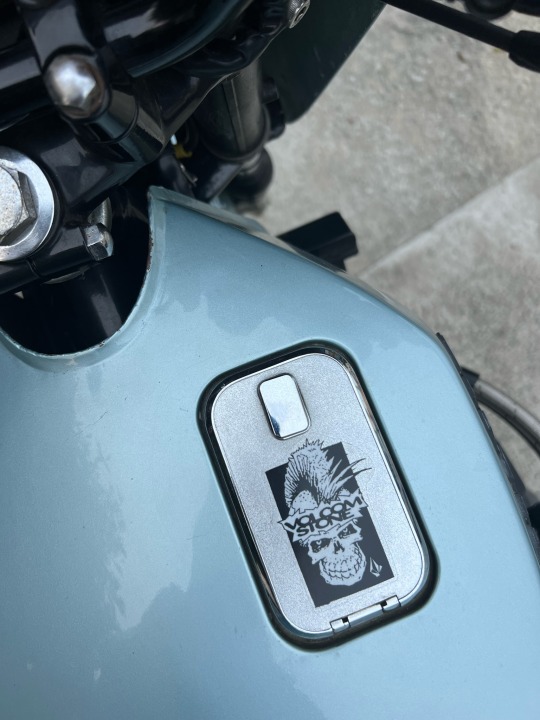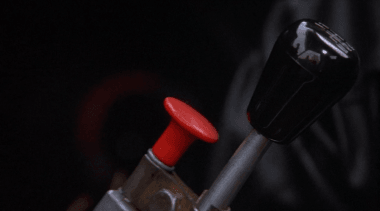#kz1000
Text

Kawasaki KZ1000
#motorcycle#kawasaki#kz1000#sport bike#racing#motorsports#ride hard or go home#built for speed#wild#freedom#lost & found#moto love#lifestyle
72 notes
·
View notes
Text

Z1-Rというバイクに乗っています。
1978年製ですから自分と同じ歳です、もうそれだけで汚れや傷、切った貼った塗った取り付けたを繰り返した車体が自分の人生と重なります。
いい歳だしナと手を出したハーレーでリターンライダーと化した自分でしたが走りが自分的には全く楽しめない事がわかりやはりアレに乗るべきだったのか…とZ1-R に。
完璧なバイクだと乗りてが思うのは想いや色々な考えが乗っかっての事、だからバイク乗り皆が最高なわけです。
0 notes
Text

KZ1000のエンジンのヘッド洗浄です。
時間をかけて綺麗にさせて頂きます。
0 notes
Text










Mad Max (1979)
#mad max gif#george miller#mel gibson#70s sci-fi#max rockatansky#70s movies#australian movies#film stunts#dystopian sci-fi#ford falcon xb#kawasaki kz1000#seventies#1979#gif#chronoscaph gif
396 notes
·
View notes
Photo

Mad Max MFP1000: Jim Goose Kawasaki KZ1000 “Kwaka” by @unikmotorcycles — a faithful replica of Jimmy the Goose’s MFP1000 from the original Mad Max. It’s the duck’s guts! Photos: @manuelportugalphoto for @rev_mc. More today on BikeBound.com! ⚡️Link in Bio⚡️ https://instagr.am/p/CvCnV2vOUoY/
107 notes
·
View notes
Text

Kawasaki Z1 production began in 1972 as the most powerful Japanese 4-cylinder 4-stroke ever marketed.
The Kawasaki Z1 is a four-cylinder, air-cooled, double-overhead camshaft, carbureted, chain-drive motorcycle introduced in 1972 by Kawasaki. Following the introduction of Honda's CB750 in 1968, the Z1 helped popularize the in-line, across-the-frame four-cylinder, a format that became known as the Universal Japanese Motorcycle or UJM.
ManufacturerKawasaki Heavy Industries, Ltd.Also calledKawasaki 900 Super Four Production1972–1975; 85,000 units. Marketed variously as the Z1-900, 900 Z1 or 900 S4 ("Super Four"), the Z1 was the first of Kawasaki's Z models.
The Z1 was noted for being the first large-capacity Japanese four-cylinder motorcycle to use the double-overhead-camshaft system on a production motorcycle. When it was introduced, only the MV Agusta 750 S used this system; it was a very expensive limited-production machine, as opposed to the Kawasaki which was less than half the price.
The Kawasaki Z1 was developed under the project name "New York Steak".In the late 1960s Kawasaki, already an established manufacturer of two-stroke motorcycles, had begun prototyping a 750 cc four-cylinder four-stroke sports motorcycle working with McFarlane Design in 1969 to develop the bike's overall appearance. When Honda introduced the CB750 to the market first, Kawasaki postponed the Z1's release until its displacement could be increased to 903 cc and the motorcycle could be marketed in the 1000cc-class.
In 1972, the Z1 set the world FIM and AMA record for 24-hour endurance on the banked Daytona racetrack, recording 2,631 miles at an average speed of 109.64 mph. Writing in 1976, LJK Setright commented that this record was only 0.36% faster than the previous figure set in 1961 at Montlhéry, France, by a team using a modified BMW R69S, particularly the engine. Also at this time at Daytona a one-off Z1 ridden by Yvon Duhamel that was tuned by Yoshimura set a one-lap record of 160.288 mph.
The Z1 was awarded the MCN 'Machine of the Year' accolade each year from 1973 to 1976 (an award resulting from a readers' opinion-poll run by UK weekly publication Motorcycle News) The Society of Automotive Engineers of Japan (in Japanese) includes the 1972 Z1 as one of their 240 Landmarks of Japanese Automotive Technology.
The basic design of the Z1 remained relatively unchanged until 1975, when the 903 cc "Z1-B" was introduced, with changes including increased power output, improved suspension, and a stiffer frame. The automatic chain oiler was deleted, the styling was revised – essentially paint scheme and side-panel nomenclature – and the braking was improved.
In 1976 the Z1 was replaced by the Kawasaki KZ900 in the U.S. and Z900 in other markets. This was succeeded by the 1977 Kawasaki Kz1000 ("Z1000") and Kawasaki Z1000 Z1-R, and in 1984 by the Kawasaki Z1100R.
3 notes
·
View notes
Text

Kawasaki Z1 production began in 1972 as the most powerful Japanese 4-cylinder 4-stroke ever marketed.
The Kawasaki Z1 is a four-cylinder, air-cooled, double-overhead camshaft, carbureted, chain-drive motorcycle introduced in 1972 by Kawasaki. Following the introduction of Honda's CB750 in 1968, the Z1 helped popularize the in-line, across-the-frame four-cylinder, a format that became known as the Universal Japanese Motorcycle or UJM.
ManufacturerKawasaki Heavy Industries, Ltd.Also calledKawasaki 900 Super Four Production1972–1975; 85,000 units. Marketed variously as the Z1-900, 900 Z1 or 900 S4 ("Super Four"), the Z1 was the first of Kawasaki's Z models.
The Z1 was noted for being the first large-capacity Japanese four-cylinder motorcycle to use the double-overhead-camshaft system on a production motorcycle. When it was introduced, only the MV Agusta 750 S used this system; it was a very expensive limited-production machine, as opposed to the Kawasaki which was less than half the price.
The Kawasaki Z1 was developed under the project name "New York Steak".In the late 1960s Kawasaki, already an established manufacturer of two-stroke motorcycles, had begun prototyping a 750 cc four-cylinder four-stroke sports motorcycle working with McFarlane Design in 1969 to develop the bike's overall appearance. When Honda introduced the CB750 to the market first, Kawasaki postponed the Z1's release until its displacement could be increased to 903 cc and the motorcycle could be marketed in the 1000cc-class.
In 1972, the Z1 set the world FIM and AMA record for 24-hour endurance on the banked Daytona racetrack, recording 2,631 miles at an average speed of 109.64 mph. Writing in 1976, LJK Setright commented that this record was only 0.36% faster than the previous figure set in 1961 at Montlhéry, France, by a team using a modified BMW R69S, particularly the engine. Also at this time at Daytona a one-off Z1 ridden by Yvon Duhamel that was tuned by Yoshimura set a one-lap record of 160.288 mph.
The Z1 was awarded the MCN 'Machine of the Year' accolade each year from 1973 to 1976 (an award resulting from a readers' opinion-poll run by UK weekly publication Motorcycle News) The Society of Automotive Engineers of Japan (in Japanese) includes the 1972 Z1 as one of their 240 Landmarks of Japanese Automotive Technology.
The basic design of the Z1 remained relatively unchanged until 1975, when the 903 cc "Z1-B" was introduced, with changes including increased power output, improved suspension, and a stiffer frame. The automatic chain oiler was deleted, the styling was revised – essentially paint scheme and side-panel nomenclature – and the braking was improved.
In 1976 the Z1 was replaced by the Kawasaki KZ900 in the U.S. and Z900 in other markets. This was succeeded by the 1977 Kawasaki Kz1000 ("Z1000") and Kawasaki Z1000 Z1-R, and in 1984 by the Kawasaki Z1100R. See less
Comments
Marnic Bert
Had one.
10w
Reply
John Wharton
One of the best looking bikes ever built. Still looks beautiful today.
0 notes
Text

Kawasaki KZ1000
117 notes
·
View notes
Text

Racecrafters KZ1000
1 note
·
View note
Text
KZ1000 Engine For Sale
The Kawasaki KZ1000 engine is a legendary powerplant that has been a favorite of motorcycle enthusiasts for decades. Originally introduced in 1977, the KZ1000 engine quickly became known for its smooth power delivery, reliability, and high performance capabilities. Today, it is still considered one of the most iconic engines of all time, and many riders continue to seek out KZ1000 engines for sale.
One of the key features of the KZ1000 Engine For Sale is its inline four-cylinder configuration, which provides a perfect balance of power and smoothness. With a displacement of 1,043cc, the KZ1000 engine is capable of producing up to 90 horsepower and 65 lb-ft of torque, making it a true powerhouse on the road. Whether you're cruising on the highway or carving up a winding mountain road, the KZ1000 engine delivers the performance you need to stay ahead of the pack.
Another standout feature of the KZ1000 engine is its durability. Kawasaki designed the engine to withstand years of hard use and abuse, making it a popular choice for both daily riders and weekend warriors. With proper maintenance, a KZ1000 engine can last for tens of thousands of miles without any major issues.
For those looking to purchase a KZ1000 engine, there are several options available. Some riders may choose to buy a used engine from a reputable dealer or private seller, while others may prefer to purchase a new engine from a Kawasaki dealer or aftermarket supplier. Regardless of where you buy your KZ1000 engine, you can be confident that you're getting a high-quality powerplant that will provide years of reliable performance.
0 notes
Text



Kawasaki KZ1000タイヤ交換出来上がりました🛞
いつもありがとうございます😊
コレでツーリングも安心ですね♪
10 notes
·
View notes
Photo

A California Highway Patrol (CHP) officer mounted on a beautiful steed who itself is done up for holidays at the Cornish Christmas in downtown Grass Valley California. Created in 1929 to provide uniform traffic law enforcement throughout the state, the California Highway Patrol was brought to the national spotlight while I was youngster in the television series CHiPs that ran from 1977 through 1983, but officers Baker and Poncherello rode Kawasaki KZ1000’s which were the actual motorcycles CHP was using at the time on LA freeways not equine officer like this one. #developportdev @gothamtomato @developphotonewsletter @omsystem.cameras #excellent_america #omsystem @bheventspace @bhphoto @adorama @tamracphoto @tiffen #usaprimeshot #tamractales @visitgrassvalley @nevadacountyca @visitcalifornia @kehcamera #omd #microfourthirds #micro43 (at Grass Valley, California) https://www.instagram.com/p/CnS2s2HPnnK/?igshid=NGJjMDIxMWI=
0 notes
Photo

Mark II Missile: 1105cc Kawasaki KZ1000 RCM-596 by Japan’s AC Sanctuary (@sanctuary_39), sporting Stage-II frame reinforcement, 17-inch @ozracingwheels, Öhlins suspension, Sculpture swingarm, forged @wossnerpistons, hand-bent titanium exhaust, and more. More today on BikeBound.com! ⚡️Link in Bio⚡️ https://instagr.am/p/Cnws-H9OFXr/
94 notes
·
View notes
Text

Kawasaki Z1 production began in 1972 as the most powerful Japanese 4-cylinder 4-stroke ever marketed.
The Kawasaki Z1 is a four-cylinder, air-cooled, double-overhead camshaft, carbureted, chain-drive motorcycle introduced in 1972 by Kawasaki. Following the introduction of Honda's CB750 in 1968, the Z1 helped popularize the in-line, across-the-frame four-cylinder, a format that became known as the Universal Japanese Motorcycle or UJM.
ManufacturerKawasaki Heavy Industries, Ltd.Also calledKawasaki 900 Super Four Production1972–1975; 85,000 units. Marketed variously as the Z1-900, 900 Z1 or 900 S4 ("Super Four"), the Z1 was the first of Kawasaki's Z models.
The Z1 was noted for being the first large-capacity Japanese four-cylinder motorcycle to use the double-overhead-camshaft system on a production motorcycle. When it was introduced, only the MV Agusta 750 S used this system; it was a very expensive limited-production machine, as opposed to the Kawasaki which was less than half the price.
The Kawasaki Z1 was developed under the project name "New York Steak".In the late 1960s Kawasaki, already an established manufacturer of two-stroke motorcycles, had begun prototyping a 750 cc four-cylinder four-stroke sports motorcycle working with McFarlane Design in 1969 to develop the bike's overall appearance. When Honda introduced the CB750 to the market first, Kawasaki postponed the Z1's release until its displacement could be increased to 903 cc and the motorcycle could be marketed in the 1000cc-class.
In 1972, the Z1 set the world FIM and AMA record for 24-hour endurance on the banked Daytona racetrack, recording 2,631 miles at an average speed of 109.64 mph. Writing in 1976, LJK Setright commented that this record was only 0.36% faster than the previous figure set in 1961 at Montlhéry, France, by a team using a modified BMW R69S, particularly the engine. Also at this time at Daytona a one-off Z1 ridden by Yvon Duhamel that was tuned by Yoshimura set a one-lap record of 160.288 mph.
The Z1 was awarded the MCN 'Machine of the Year' accolade each year from 1973 to 1976 (an award resulting from a readers' opinion-poll run by UK weekly publication Motorcycle News) The Society of Automotive Engineers of Japan (in Japanese) includes the 1972 Z1 as one of their 240 Landmarks of Japanese Automotive Technology.
The basic design of the Z1 remained relatively unchanged until 1975, when the 903 cc "Z1-B" was introduced, with changes including increased power output, improved suspension, and a stiffer frame. The automatic chain oiler was deleted, the styling was revised – essentially paint scheme and side-panel nomenclature – and the braking was improved.
In 1976 the Z1 was replaced by the Kawasaki KZ900 in the U.S. and Z900 in other markets. This was succeeded by the 1977 Kawasaki Kz1000 ("Z1000") and Kawasaki Z1000 Z1-R, and in 1984 by the Kawasaki Z1100R.
2 notes
·
View notes




